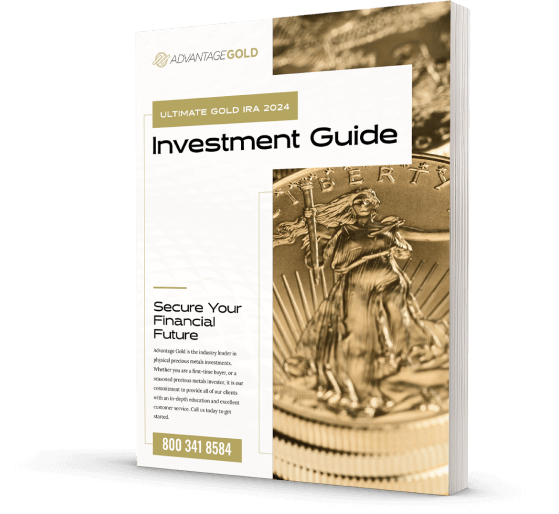#1 Rated Gold Company in America.
There are many ways for investors to get exposure to the precious metals markets. You can buy shares of mining companies, buy shares of exchange-traded funds (ETFs) backed by gold or silver, buy or sell gold or silver futures contracts, and even purchase gold or silver certificates.
While investments like certificates and ETFs provide exposure to precious metals markets, they’re not a substitute for purchasing real, physical gold or silver. Let’s walk through how GLD and other ETFs compare to physical gold ownership and when they might make sense for your investment priorities—and when they don’t.
Gold ETFs give investors a vehicle for participating in the gold market without having to take physical delivery of the gold. ETFs are typically traded on a regulated exchange where investors purchase shares in the fund. Each share represents fractional, undivided ownership interest in the trust’s assets. These assets take the form of gold bullion and sometimes cash.
GLD—or the SPDR Gold Shares ETF—is one of the largest gold ETFs. As of August 2023, the fund’s roughly 29 million ounces held a net asset value (NAV) of over $56 million. Each of the ETF’s shares is worth 0.06052 ounces.
While GLD is one of the most popular ETFs, it’s not the only one. Other common choices for precious metals investors include the following funds:
Buying gold ETFs isn’t the same thing as purchasing physical gold, and it’s incredibly important that you understand this before you make either investment.
When you buy a gold ETF, you’re buying shares of a trust that holds gold bullion. When you buy physical gold, you’re taking direct ownership of actual gold coins or bars you can hold in your hand. You’re also not purchasing fractional shares. You’ll own each ounce of gold outright and can sell it for its current value.
Of course, buying physical gold comes with its own quirks. You’ll have to figure out a storage solution, either in your own home, in a safe deposit box, or in the custody of a depository. And while this does add to the cost of gold ownership, it gives you direct ownership and control over your gold.
GLD and other gold ETFs might be considered a good investment for specific types of investors. They’re an easy way to gain exposure to gold markets without the need to physically purchase, store, or insure gold.
Before you invest, do your research and consider your financial goals. Weigh them against your risk tolerance and investment timeline. That said, always consult with your financial advisor before you make an investment.
Investing in GLD (and other ETFs) does carry a few significant risks:
Buying physical gold offers plenty of perks compared with purchasing shares in mining companies or ETFs. When you purchase physical gold bullion, you enjoy the following benefits:
As you can see, owning shares of GLD or any other “paper” gold product is not the same as owning a physical gold bullion that you can touch and feel. While it can be excellent exposure to the market, it does not provide the same benefits of buying liquid, tangible gold that you can sell or trade.
If you do not own physical gold or precious metals, now may be the time to consider adding an allocation to your portfolio. If you own shares of paper gold products, now may be the time to consider additional options.
You either own gold, or you own paper…
If you are interested in learning more about the potential benefits of owning physical gold bullion, we encourage you to speak with one of our account executives today. Our precious metals professionals can show you the most convenient way to begin building a precious metals portfolio or add to existing holdings.
Talk to an IRA advisor about how to roll over your 401(k) into a Gold IRA by opening a self-directed IRA account, contact us or call us at 800-341-8584 today.

Please note that Advantage Gold and its representatives are not licensed or registered investment advisers, attorneys, CPA’s or other financial service professionals. We do not offer or render any legal, tax, accounting, investment advice or professional services. Additionally be aware that precious metals carry risk of loss and are not a suitable investment for everyone. Past performance is not necessarily indicative of future results and you should always consult your financial and tax professional and carefully evaluate all risks associated with the acquisition of precious metals before making the investment.
The statements made on this website are opinions of Advantage Gold LLC. Past performance is not necessarily indicative of future results. Precious metals, Gold American Eagles, Proof Gold American Eagles, certified gold coins, as well as gold and silver bars carry risk and investing in precious metals directly or through an IRA is not suitable for all investors. Precious metals and coins (i.e. Canadian Gold Maples, Canadian Silver Maples, American Gold Eagles, American Silver Eagles, Proof Gold American Eagles, Proof Silver American Eagles, Certified Gold American Eagles, Numismatic Gold Coins) may appreciate, depreciate, or stay the same depending on a variety of factors. Precious metals can and will fluctuate unexpectedly. Advantage Gold cannot guarantee, and makes no representation, that any metals purchased (i.e. .999 gold bars, .9999 silver bars, or any gold coins) will appreciate at all or appreciate sufficiently to produce a profit above and beyond the mark up/ commissions charged whether they are bought for direct delivery or inside of a precious metals IRA. The decision to purchase or sell precious metals with cash or inside of a Gold IRA or a Gold Backed IRA, and which precious metals to purchase or sell, are the customer’s decision alone, and purchases and sales should be made subject to the customer’s own research, prudence and judgment. By accessing any Advantage Gold content, you agree to be bound by the terms of service. Review the terms of service and privacy policy.
*Consult your tax Advisor.